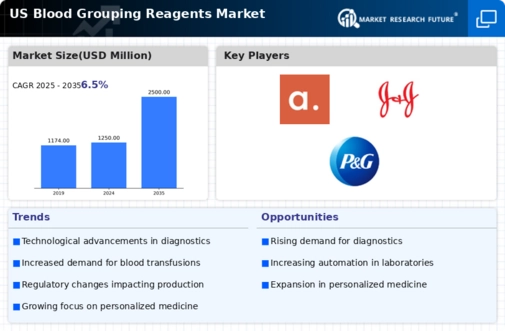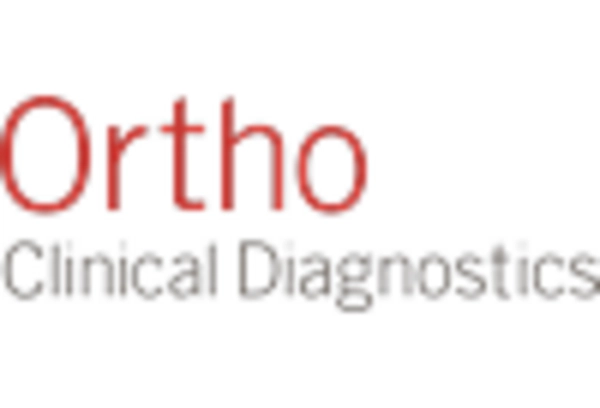Rising Prevalence of Blood Disorders
The increasing incidence of blood disorders in the US is a crucial driver for the blood grouping-reagents market. Conditions such as anemia, hemophilia, and sickle cell disease necessitate accurate blood typing and matching for effective treatment. According to the Centers for Disease Control and Prevention, approximately 3 million individuals in the US are affected by anemia alone. This growing patient population is likely to elevate the demand for blood grouping reagents, as healthcare providers require reliable and efficient testing solutions. Furthermore, advancements in diagnostic technologies may enhance the accuracy of blood typing, thereby fostering market growth. The blood grouping-reagents market is poised to benefit from this trend, as healthcare facilities increasingly invest in state-of-the-art reagents to ensure patient safety and effective treatment outcomes.
Expansion of Healthcare Infrastructure
The ongoing expansion of healthcare infrastructure in the US significantly impacts the blood grouping-reagents market. With the establishment of new hospitals, clinics, and diagnostic laboratories, the demand for blood grouping reagents is expected to rise. The American Hospital Association reported that there were over 6,200 hospitals in the US as of 2023, and this number continues to grow. Enhanced healthcare facilities are likely to adopt advanced blood grouping technologies, which could lead to increased reagent consumption. Additionally, the integration of blood grouping reagents into routine laboratory practices may further stimulate market growth. As the blood grouping-reagents market adapts to these infrastructural changes, it is anticipated that the availability and accessibility of these essential reagents will improve, ultimately benefiting patient care.
Increased Focus on Blood Donation Drives
The heightened emphasis on blood donation drives in the US serves as a significant driver for the blood grouping-reagents market. Organizations such as the American Red Cross actively promote blood donation campaigns, which are crucial for maintaining adequate blood supplies. As more individuals donate blood, the need for accurate blood typing and matching becomes paramount. This trend is likely to increase the demand for blood grouping reagents, as healthcare providers require reliable testing solutions to ensure compatibility. The blood grouping-reagents market may experience growth as a result of these initiatives, with an anticipated rise in the volume of reagents utilized during blood donation events. Furthermore, educational campaigns aimed at raising awareness about the importance of blood donation could further bolster market demand.
Technological Integration in Blood Testing
The integration of advanced technologies in blood testing is a pivotal driver for the blood grouping-reagents market. Innovations such as automated blood typing systems and molecular diagnostics are transforming traditional testing methods. These technologies enhance the accuracy and efficiency of blood grouping, which is essential for patient safety. The blood grouping-reagents market is likely to benefit from the adoption of these advanced systems, as healthcare facilities seek to improve their testing capabilities. Moreover, the increasing trend towards point-of-care testing may further drive the demand for rapid and reliable blood grouping reagents. As technology continues to evolve, the market is expected to witness a shift towards more sophisticated testing solutions, ultimately enhancing the overall quality of care.
Growing Awareness of Blood Safety Standards
The rising awareness of blood safety standards among healthcare providers and patients is a significant driver for the blood grouping-reagents market. Regulatory bodies in the US emphasize the importance of adhering to stringent blood safety protocols to prevent transfusion-related complications. This heightened awareness is likely to lead to increased investments in high-quality blood grouping reagents, as healthcare facilities strive to comply with safety regulations. The blood grouping-reagents market may experience growth as hospitals and laboratories prioritize the use of reliable reagents to ensure patient safety. Furthermore, educational initiatives aimed at informing healthcare professionals about the latest blood safety standards could further stimulate demand for advanced blood grouping reagents, reinforcing the importance of quality in blood testing.

















Leave a Comment